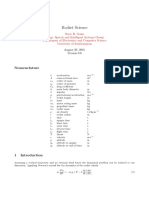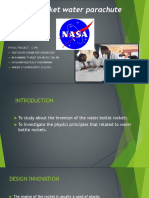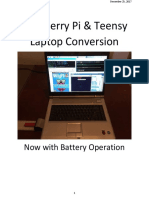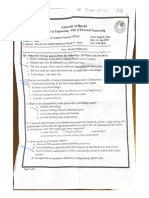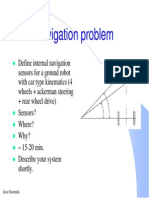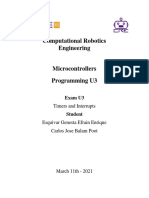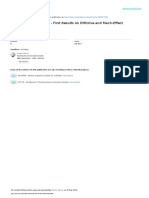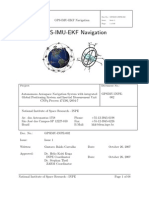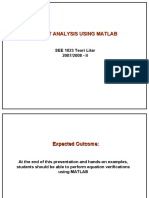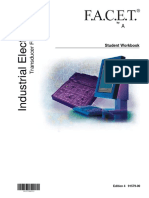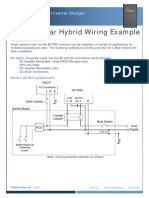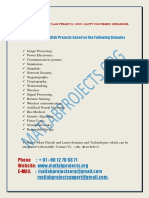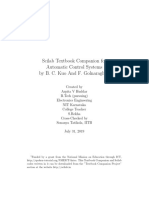0 ratings0% found this document useful (0 votes) 68 views12 pagesRocket Info
Copyright
© © All Rights Reserved
We take content rights seriously. If you suspect this is your content,
claim it here.
Available Formats
Download as PDF or read online on Scribd
PEPER AMAA
BAEF IOS y MRS�Fundamentals of Model Rocketry
s#x Principle of Propulsion of Model Rockets
‘To briefly explain how a model rocket flies, suppose that Mr. A and Mr. B, who weigh the
same, are on roller skates and facing each other on a flat surface. If Mr. A pushes Mr. B as
hard as he can, Mr. B will naturally fall back. This is because the exact same force that
pushed Mr. B will work in the opposite direction. This is called “action-reaction,” in the third
law of Newtonian kinematics.
Ina model rocket, the combustion of the engine causes the exhaust gases to be ejected
at high speed towarcs the earth's surface. During this, the rocket body is subjected to the
same force in the opposite direction based on the “action-reaction’ principle, so it fes into
the sky.
The simplest principle of propulsion for model rockets is the rubber balloon. When you
blow air into the balloon to inflate it and release your hand, it will fly away. The air in the
balloon has mass even though it seems very light. Moreover, it is compressed and dense.
Blowing this massive air backward is the action, and the reaction makes the balloon go
forward.
+ Air Resistance (Drag)
When you inflate the balloon and then letitfiy, it spins around, and you have no idea
where it is going. This is because air resistance is a major force that prevents balloons from
lying. This force is proportional to the shape of the object and the density of the air, and
also increases in proportion to the square of the speed.
This is expressed by the formula: D; Drag Force (N) V: Velocity
2 5 ty(mis)
D=1/2C,pV7A —_C,; Drag Coefficient A; Reference Area(m’)
As shown in the figure on the right, try ; Atmospheric Density
swinging your arm with your palm up OF Oa Fees Du Ar Cay
down. If you swing it slowly, you will not
feel much difference, but if you swing Shape with Low Drag Force
quickly, you will notice the magnitude of ua) é Sa
resistance changes depending on your ~ =
hand shape. This is because the
resistance is proportional to the
reference area (projected area) of the
‘object and also proportional to the
square of the velocity. Drag force wil differ based on the shepe of the abject.
The drag coefficient (C,) varies
depending on the shape andsurface Streamlined,
of the object, and the coefficients for
4 types of shapes are shown below.
Dr
Shape oethisert
‘Square 1.05
Wind
Sphere 0. 47 V o
Streamlinedwersons] OL 1 Steamlned sohere Cube
‘Streamlined 0.05 (Rear Truncated)
Comparison of object sizes when drag is equal
To make a model rocket fly high, it is necessary to reduce as much air resistance(drag) as
possible. This drag is divided into four types depending on how itis generated: skin friction drag,
form drag, induced drag, and interference drag. To reduce drag, the shape of the rocket body
and fins (tail fins) should be made smooth and aerodynamic, and if possible, the rear of the
rocket should be streamlined. Painting or polishing the surface is also effective.�> Center of Gravity and Center of Pressure
When a model rocket flies through the air, if ihe balance between the center of gravity and
the canter of pressura is not right, the rocket will not fly straight. Next, we will explain the
meaning of the center of gravity and center of pressure and a simple way to obtain them,
‘© Center of Gravity (CG) and How to Find It
This refers to the center of mass of a model racket, including the engine. It can be thought of as
‘the point where overall mass, momentum, potential energy, and gravily are concentrated even
when the rocket is moving forward orretaling. The engine is at the rear and it works against this
center of gravity, and during powered flight, as fuel buns, the center of gravity moves forward.
A simple way to find the cantar of gravity
(CG) is to balance tha completad madel
rocket on a wedge-shaped object as
shown on the right, The center of gravity
is the point where the rocket is horizontal.
(At this time, the rocket should be
equipped with engines, recovery wadding,
parachutes, etc... and the measurement
should be made under launch conditions.)
© Canter of Pressure (CP) and How to Find It
Each part of the model rocket during flight is subjected to its own air pressure. The center of
pressure (CP) is the point at which thase pressures can be treated together as a single force,
and it moves back and forth depending on the angle of attack, 90 degrees is the mast forward,
and a small angle of atlack is the most rearward
Tha GP can be caloulated from the shape
of the fuselage, but we can prepare a
silhouette of the rocket (right diagram)
whare the point that is balanced is the
center of pressure.
This method is called tha cardboard
cutout method,
A general model rocket kit has a CP
calculated at an angle of attack 80°, in
which the CP is located at the most forward
it can possibly be located at. Though wind =. Diraction of Mation
direction will vary more, a stable fight can EF a
be conducted. ‘Angle of Attack
Vertical Axis
iS
— Diagram of
*& Stable Rocket Flight Angle of Attack
Rockets fly through air without any support after it is launched. If the center of gravity of the
rocket were on its central axis, the converging line of the engine thrust would have to coincide
with the central axis. If there is even the slightest deviation, the rocket will start to pivot and
deviate from its correct trajectory.
When building a model rocket, the angine
mount must be precisely aligned with the
‘central axis of tha rocket. a
However, because its difficult to ensure 2
‘that the engine thrust is even across the ia
entira nozzle cross-section, itis impossible -
for the ling of thrust to always coincide with
the central axis line. ‘ic in
The mation of a rocket is divided into three
axes of motion: roll, pitch, and yaw, as
shown in the figure on the right.
Rocket Movement (Roll, Pitch, and Yaw )�In a real rocket, the thrust is
automatically changed to adjust its
direction, but in a small rocket like
the model rocket, it can be stabilized
by adding fins at the rear so that the
force of air works away from the rear
of the center of gravity.
There are three possible positions
for the center of gravity and the center
of pressure, as shown in the figure on
the right. Dis positive, 2 is neutral,
and © is negative.
‘The model rocket will not undergo
stable flight unless the center of gravity
is in front of the center of pressure.
Therefore, is the best option.
When building your own model
rocket, the ratio of overall length to
diameter should be at least 10:1. The
distance between the center of gravity
and the center of pressure should be
equal to or greater than the diameter.
~~ The Swing Test
To check the stability of a rocket,
the center of gravity and center of
pressure can be determined using the
aforementioned methods and
formulas, or by conducting the
“Swing Test’
‘Attach the engine, parachute, etc. to
the rocket, and tie the rocket to the
center of gravity with a strong string
such as a 3-m-iong kite string so that
the rocket is horizontal, and secure it
with tape.
Hold one end of the string and
‘swing it around in a large circle.
Stability (positive) can be confirmed
when the rocket is heading in the
correct direction of travel, even with
slight changes in speed and up and
down waves.
Ifthe rocket goes around in circles it
is neutral, and if it goes backwards
and forwards, it is negative. If this is
the case, increase the size of the fins
or fil the nose cone with clay and test
again
‘Once stability is confirmed, lower
the position of the string backward
slightly in a position where the nose
cone points down about 10 degrees,
and swing it around in the same
manner. If the nose cone still moves
stably in the direction of travel, itis
considered to be sufficiently stable.
Kl
rection the rockets gong. “The tip ofan ancmamstor
faces th decton off wn
The rocket's stability is maintained by the fins.
(\
) CHES
@ Positive
@ Neutral @ Negative
Relationship Between the Location of the Center of
Gravity and Center of Pressure of the Rocket
yore
When the area of the fine are
4.2% 1.2 times the area of the
fuselage itis stable
}) 120
120
Atleast 100
Things to Consider When Building Your
Own Model Rocket
The Swing Test
[tach ths thas athe pion
wha the rocket tp i about 10"
oxy Fon 9
Stability Test of Model Rocket�+ The Multistage Method
A multistage rocket is used to fly a model rocket to a
higher altitude: the second stage is ignited as soon as Expect
the first stage finishes burning, and the first stage is
detached by the gas from the second stage, and the
rocket continues to fly. Then, a recovery device
(streamer) is activated to return the rocket to the ground
In the first stage, the engine used is called the
booster engine, which has no delay charge or
ejection charge. The engine rating system is
indicated as 0 for the last delay time, and there are
three types: A10-0T, B6-0, and C6-0.
‘The engine used for the second stage is called an
upper stage engine, which has a longer delay time of
5-7 seconds to facilitate rocket recovery.
When launching with the multistage system, the
total combined engine gunpowder should not exceed
20g using the standard gunpowder reference below. 2 Barel 3 Cluster
we The Cluster Method .
if the multistage system is used to achieve higher Ht _
altitudes, the cluster (bundle) or parallel (arrangement) |
method is used to launch heavier loads, as seen on the 3 Baral
diagram to the right. This method increases the 4 Cluster
instantaneous thrust so that the maximum weight of the
load can be increased efficiently, but it is structurally
disadvantageous, having reduced efficiency for an }
aircraft that lifts with a single engine. Also, the cluster
Cluster (parallel) method
method involves igniting multiple engines
simultaneously, so a controller with a low electric current
of 6V cannot be used. Please use a capacitor-charged 5 +
type or one with a large electric current of 12V as the . SF
controller. SG
When launching with the cluster method, use the same =
type of engine and make the total gunpowder amount a
maximum of 20g when creating the combination.
The right diagram shows the connection method of the +
ignitor as well as the clip whip (the combination part of -
the micro clip) when clustering.
Multistage (two-stage) method and engine example
Clip Whip
#< Gunpowder Standard Reference (Japanese Association of Rocketry Approved)
Engine Type | Kwanris) | Engine Type | Snceng) | Engine Type | wena
Ag-4T ae | Be-o $s | Bens ae
Al)-0T 40 B6-2 11 c5-3 14.5
Al)-3T Ag B6-4 a4 c6-0 13.0
WtA6-2 ae B4a-2 a1 Cc6-3 4.2
A8&-3 68.6 B4a-4 4.8 C6-5 14.9
AB-5 63 B4a-6 10.5 c6-7 18.6
3% Engines that fall under the category of gunpowder flares are limited to FA cerlfied C type engines that
are a maximum of 20g of total gunpowder (including the ignitor)
3 The gunpowder amount of the engine includes the propellant, delay composition, ejection charge, as
well as the ignition powder for the booster engine combined. The gunpowder of the ignitoris 0.029,�Model Rocket Structure and The Flight Process
The engine structure consists of the three layers of the propellant, delay composition,
and the ejection charge, where after the propellant combustion, inertial flight at a
specified time is conducted and the parachute ejection charge is ignited. To protect the
parachute from the heat generated, fireproof paper called the recovery wadding is
inserted between the engine and the parachute.
With this curriculum, you can obtain a grade 4 model rocket license.
Usable Engine Range for Grade 4 Model Rocket License (Based on Notification 499)
Type _| Net impulse Ns) [Combustion Time (s)| Delay Time (s)
18-3 2.5 0.32 3
86-4 5.0 0.83 4
(5-3 10.0 2.10 3
c6-7 10.0 1.70 7
Election Charge
(Parachute Ejection)
Delay Time / Seconds @ Callecion System Release
‘Avorage Newtonian
Theust
Not Impulse
Clacton System
Delay Compesition (to extend s : Opens
time unt! parachute ejection)
Exhaust Nozzle Solid State Fuel (for thrust)
‘ Structure of a Modal Recket
Rise and Acceleration
{rom high thrust
Lanaing ane
Screw Eye Callecton
‘Shock Cord
Snap Swivel
‘Shock Cord Mount
Body Tube Parachute
(teemer
Recovery Wadding ‘ .
(Flome-resetant paper)
Fight Process!
Engine Btock Launch Lug Pipe
Space Ring
‘© Modal Rocket Engine Charactrsties (Basic Structure dad Functiens)
Engine Hook Engine Mount Tube�Necessary Items in the Model Rocket Launch
Recovery Wadding
(Flame-resistant
Paper)
(ye fea Geof)
. Ignitor Pi
Launch ignitor Pug
Controller
a > s
Launchpad Engine for Ignitor
Model Rocket
Preparation for Model Rocket Launch
1 =. Setting up the Collection Device ®
A. Gently crumple up the necessary —— oe
amount of recovery padding, and
lightly stuff it in the body tube. Pull
(G for Alpha III) Fold
B. Make sure the parachute lightly
slides in the body tube. a v Roll up
If itis tightly packed, fold it again g
from the start and stuff it back in. Q yp
C. When inserting the nose cone in
the body tube, be careful not to get
the shroud lines and the shock
cord caught in it. © Insertthe nose cone
Wrap the string lightly
around the parachute and
insert in the tube�2. Installation of Igniter Plug
®
Caution The igniter tip must touch the
>
E. Insert the igniter plug.
F., Push it in slowly.
G. Bend the end of the igniter wire.
H, Insert the engine into the rocket
propellant in the engine nozzleto (pap{pasfpafpaa-s0 (pap
ignite.
Igniter plugs are marked with a A8-3 engine — Yellow
tag and color to indicate which
engines they can be used on.
. Cut the paper tape with scissors
to separate the igniter. | | ©
i@
. Igniter wires that are attached to
the igniter should be separated. V
Do not use a wire with a broken
end. ©
Place the igniter straight into the
engine nozzle hole.
No. ves
9 yw. e
Propellant Fold and Bend
and secure it with the engine
hook.
A.
Launch and Collection
Launch Area
% Make sure the launchpad is set in a large open Microclip
area at least 50m away from houses, power |
lines, trees, and obstacles in all directions.
% Make sure there are no dry leaves or easily
combustible objects in the are of the launchpad.
+ The launch controller is placed 5m away a a)
from the launchpad, and the lead line with
the microclip is passed once through the Leave 5m of space
hole in the leg of the launchpad.�6 . Launchpad Setup
4x The launchpad should be set up so that it
can be angled in the direction of the wind.
4 The launchpad should be secured with a picket
or other means to prevent it from breaking.
% Launch rods should not be tilted more
than 30 degrees.
c- Countdown and Launch
% Ensure that the safety key on the firing controller is pulled out.
4 Take the safety cap off the launch rod and thread the launch lug
pipe of the rocket through the launch rod.
% See if the rocket moves smoothly along the launch rod.
4x Connect the microctip to the igniter lead. At this point, make sure that
the microclip does not come into contact with any other metal parts.
x Insert the safety key into the firing controller and check that the
miniature light bulb comes on.
+ When all launch preparations are complete, start the countdown.
More than 30°
Launch Rod
Stabilize with
Direction
neket 0p of the wind
mek R71 | On the launch. OK!
Seni 1 | Notow fying aircraft
vmzmsat welll
5.4.3, 2] Teminus tive... Four...
.1l aki | Three... Two... One...
Ignition!
CChack that thera ie
no one around,
Look around and
check the sky
above.
4. Hold down the
bo. After Launch
4 After each launch, remove the safety
key from the launch controller.
4. The removed safety key should be left inserted
asa safety cap at the end of the launch pad
launch rod until the next launch,
The safety key and safety cap must
always be connected by a single string
satay key. Microctip
2. Press and hold
the fring button
Alter inserting the safety key,
press ard hold itto urn on the
lamp. Toit, goss both the safely
key and he igation ting baton,
Press both
buttons when
firing
Safety Cap
Launch Rod
Launch Controller Safety Key�Model Rocket: Points To Look Out For When Launching
,
te Stabilize the launchpad with the picket. Do At most 30°
not turn it more than 30° from the vertical.
Don’t let the
picket make it fall
te Have a fire extinguisher or a bucket filled
with water ready near the launchpad.
Bucket of Water
+ All engines/igniters must be kept in G
separate boxes that are not metallic.
Separate in a Plastic/Vinyl Box
ste Check to see that your engine does not
have any cracks and that it is not 4
damaged A is
No Smoking!
ye Do not light any fire around the
engines.
# Allengines must be placed at least NO FIRES
20m from the launchpad.
+ Donot bring more than one At least 20m
engine to the launchpad.
Veen
+ Anyone unrelated to the launchings
are prohibited from entering the
engine placement area.
~*~ Be careful not to get your
engine stolen.
+ Do not launch in strong wind, rain
or thunder. (Wind Speed 8m/sec)�In Case of Misfire (if it doesn’t launch)
If the engine fails to ignite, remove the safety key from the launch controller and wait
30 seconds before investigating the cause.
If the igniter tip was burning but the engine did not ignite, it is because the igniter
tip was not touching the engine propellant. Replace with a new igniter and start
over.
It the igniter tio is not burning. # is either in poor contact with the microclip or there is
insuffcient battery capacity in the launch controller. The microciip should be occasionally
polished with sandpaper on its surface. If the batteries are low in capacity, replace all four
with new alkaline batteries.
More than 90% of all misfires are caused by the two causes listed above. Other
possible causes include shorted or broken leads, but advice should be sought
from experienced persons.
Enjoy a Safe Launch
Ifthe rocket opens its parachute above you and starts descending gradually, check the
landing point before retrieving it. It is very dangerous to chase it while looking up.
Ifthe rocket falls into a pond or river, or gets caught in tall trees or
power lines, do not try to retrieve it and give up.
Used up engines and igniters must be collected after launch and taken back for disposal.
Modifying the engine or using it for any other purpose is prohibited
by law. Never do this for your own safety.
Ifan engine is accidentally damaged or is found to be outwardly damaged, it should
be thoroughly soaked in water and then disposed of (buried in soil
Ifit starts to rain heavily or there is thunder, the launch will be immediately suspended. The
same applies if there is wind speeds of 8 m/s or more. If the weather does not improve
after a short period of time, the launch will be stopped there.
Observe the safety regulations for model rockets (Voluntary Consumption Standards -
established by the Japan Model Rocket Association) when launching.
Let's enjoy the launch!
Astrocam 110
(Obsolete type)
Cn
i
2 Caesar Wing transport
(Rotary-wing mode! Glider)
Hercules
(two-stagod eystom)�saul] Jamod pue
ng ‘speoy
wg Ise] Je BouR;sIG - auiBue o/g edAy YIM BulyoUNe s6ul
i
| WG] 1S29] Je S9URISIQ = sUIBUS y odA] Ym BuIyoUNe]
Jae
BO rroune ou, HOR BEENY
=S | 73 See = oO» ‘skqpueys youne| 0) WO},
C48 J 5
qj -
Aqsiassed
v
v Ke v
pedyoune7 ay} woi4 saoue}sig ay) ae
